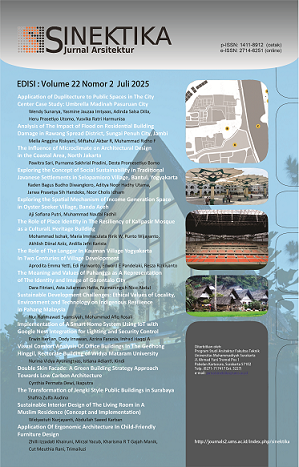Sustainable Interior Design of The Living Room in a Muslim Residence: Concept and Implementation
-
DOI:
https://doi.org/10.23917/sinektika.v22i2.10436Keywords:
Implementation, Interior Design, Islamic, Living Room, SustainableAbstract
The interior design of the living room in a Muslim residence needs attention, because privacy in the house is strictly maintained, so it is necessary to implement a living room interior design that is based on Sharia. The objectives of this research are 1). Developing a living room interior design concept, 2) implementing an Islamic home interior design that is functional, aesthetic, and Islamic. This design is a combination of Islamic and sustainable concepts. The Sharia referred to is the mahram structure of the Muslim family, which has an impact on the hierarchy of spatial zones. The supporting approach is Islamic ethics in space and Islamic decorative arts. Sustainability is realized in the choice of environmentally friendly materials. The method used is a mixed literature study that takes references to Islamic values mentioned in the Al-Qur'an and Hadith and then applies them to research related to the concept of sustainable housing. The results of this research are the concept and implementation of sustainable living room interior design, including the hijab, Islamic decorative arts, sustainable architecture, and environmentally friendly materials.
Downloads
References
Al-Faruqi, I. R. (1999). Seni Tauhid Esensi dan Ekspresi Estetika Islam. Yogyakarta: Yayasan Bentang Budaya.
Al Mushaf ash-Sharif, Al Qur'an dan Terjemahan. (2000). Medina: Mujamma'al Malik Fahdli Thiba’at Al Mushaf asy-Syarif.
Baqi, Muhammad F. A. (2005). Mutiara Hadis Sahih Bukhori-Muslim. Surabaya: Bina Ilmu
Dold-Samplonius. (1999). The Topkapi Scroll—Geometry and Ornament in Islamic Architecture: Topkapi Palace Library MS. H. 1956; With an Essay on the Geometry of the Muqarnas by Mohammad al-Asad. By Gülru Necipoǧlu. Santa Monica (The Getty Center for the History of Art and the Huma. Historia Mathematica, 26(2), 166–172.
Embi, M. R., & Abdullahi, Y. (2012). Evolution of Islamic Geometrical Patterns. Global Journal Al-Thaqafah, 2(2), 27–39. https://doi.org/http://dx.doi.org/10.7187/GJAT202012.02.02
Esen, R., & Uysal, B. (2019). The analysis of living room furniture and room spaces used by families relation of West Black Sea Region in Turkey. Engineering Science and Technology, an International Journal, 22(2), 692–696. https://doi.org/10.1016/j.jestch.2018.12.011
Fajariyah, L. (2021). Quranic values on the jamik mosque architecture in sumenep. Journal of Islamic Architecture, 6(3), 187–195. https://doi.org/10.18860/JIA.V6I3.9921
Groat, L., & Wang, D. (2013). Architectural Research Methods (Second Edi). New Jersey: Jihn Wiley & Sons.
Gupta, A. (2017). Building a Green Home Using Local Resources and Sustainable Technology in Jammu Region - A Case Study. Energy Procedia, 115, 59–69. Elsevier B.V. https://doi.org/10.1016/j.egypro.2017.05.007
Iskandar, Asysyauki, A. H., Angrini, S. N., & Diem, A. F. (2024). Analisis Semiotik Elemen Arsitektur Islam pada Rumah Adat Komering : Studi Terhadap Rumah Carahulu Semiotic Analysis of Islamic Architectural Elements in Komering Traditional Houses : A Study of Carahulu Houses. Jurnal Arsir, 8(2), 251–263.
Jaya, A. P., Hanum, M., & Andriyali, D. (2023). Nilai-Nilai Islam Pada Arsitektur Rumah Tinggal Etnis Arab Di Kampung Al–Munawar 13 Ulu Palembang. Jurnal Ilmiah Arsitektur, 13(1), 31–41. https://doi.org/10.32699/jiars.v13i1.3650
Keskin, K., & Erbay, M. (2016). A Study on the Sustainable Architectural Characteristics of Traditional Anatolian Houses and Current Building Design Precepts. Procedia - Social and Behavioral Sciences, 216(October 2015), 810–817. Elsevier B.V. https://doi.org/10.1016/j.sbspro.2015.12.078
Mortada, H. (2003). Traditional Islamic principles of Built Environment. London: RoutledgeCurzon. https://doi.org/10.4324/9780203422687
Nurjayanti, W. (2004). Aplikasi Konsep Islam pada Rumah Tinggal. Prosiding Simposium Nasional Arsitektur Islam. Arsitektur UMS.
Nurjayanti, W. (2019). Konsep Arsitektur Islam. Sukoharjo: Muhammdiyah Universitu Press.
Nurjayanti, W., Aly, A., & Ronald, A. (2014). Karakteristik Rumah Tinggal dengan Pendekatan Nilai Islami. Simposium Nasional RAPI XIII-2014 FT UMS, A90–A96.
Nurjayanti, W., & Nugrahaini, F. T. (2023). Sustainable Islamic Architecture in Settlements and Their Environment in Surakarta. Journal of Islamic Architecture, 7(4), 750–759. https://doi.org/10.18860/jia.v7i4.19204
Özbay, F. (1999). Gendered Space: A New Look at Turkish Modernisation. Gender & History, 11(3), 555–568. https://doi.org/https://doi.org/10.1111/1468-0424.00163
Pramono, A. (2012). Implementasi Al-Qur’an Dan Al-Hadits Pada Arsitektur Andalusia. Journal of Islamic Architecture, 1(1), 21–26. https://doi.org/10.18860/jia.v1i1.1717
Rashdan, W., & Ashour, A. F. (2022). Aesthetic Interpretation for Islamic Geometry in Interior Design. WIT Transactions on the Built Environment, 211, 89–101. https://doi.org/10.2495/IHA220071
Safitri, N., Armelia, D., & Fidyati. (2024). Penerapan Konsep Arsitektur Islami pada Rumah Tinggal BTN Paya Bedi, Aceh Tamiang. Rumôh: Journal of Architecture, 14(1), 21–27.
Sumalyo, Y. (2006). Arsitektur Mesjid dan Monumen Sejarah Muslim. Yogyakarta: UGM Press.
Yasmin, D., & Nilufar, F. (2023). Adaptability in Interior Space: Public Housing for Lower-Middle Income Group in Dhaka. Interiority, 6(1), 115–136. https://doi.org/10.7454/in.v6i1.251
Yin, R. K. (2008). Case Study Research: Design and Methods. Jakarta: Raja Grafindo Persada.
Downloads
Submitted
Accepted
Published
Issue
Section
License
Copyright (c) 2025 Sinektika: Jurnal Arsitektur

This work is licensed under a Creative Commons Attribution-NonCommercial 4.0 International License.











